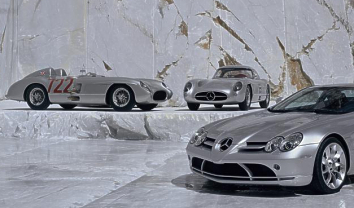
.
.
June 04, 2003
.
This Week:
-
Mercedes-Benz to Debut SLR McLaren This Fall New SLR Super Sports GT to Debut at Frankfurt Show
-
The 911 Carrera 4S Cabriolet is ready to hit the road in October
-
Volkswagen once again leads the field in patent applications
-
TABC Announces 4-Cylinder Engine Assembly - Toyota Parts Plant Expands Capabilities
-
Mille Miglia 2003: Boni and Barziza Pilot a BMW 328 to Win the Lady Trophy
-
The exclusive SL-Class "Mille Miglia" special-edition model takes to the stage
© 1998
- 2003 Copyright &
Disclaimer
Automotive Intelligence,
www.autointell.com
All Rights Reserved .
For questions please contact
editor@autointell.com
.
Mercedes-Benz to Debut SLR McLaren This Fall New SLR Super Sports GT to
Debut at Frankfurt Show

Mercedes-Benz McLaren, the original 300SLR roadster and the "Uhlenhaut Coupť" (in background)
Photo: DC
|
MONTVALE, N.J. - The new Mercedes-Benz SLR McLaren, which is set to celebrate its world premiere this fall at the Frankfurt Auto Show, celebrates the formidable SLR race cars of the 1950s and marks a new era of Mercedes-Benz passion for grand touring sports cars. A futuristic interpretation of styling elements from the original 300SLR and from the latest Formula 1 Silver Arrow race cars bridges the past and future, bringing cutting-edge motorsports-inspired design and technology to the road, just as the SLR did in 1955. The new SLR allows Mercedes-Benz and its Formula 1 partner McLaren to showcase their collective experience in the development and production of high-performance sports cars. This unique combination of expertise is evident not only in the pioneering developments and impressive performance of the new SLR, but also in its high levels of safety, as well as the grand touring comfort already associated with the renowned SL. |
|
The limited-production SLR will go on sale in Europe late this year, and its U.S. market launch is planned in mid-2004. While pricing will be announced later, it's expected to be in the mid-$300,000 range.
Carbon Fiber Body
One dramatic example of technology transfer from Formula 1 racing is the carbon fiber composite construction of the new SLR McLaren monocoque and body panels, which provides rigidity and strength never before achieved in road-going vehicles, with reduced weight to help ensure the SLR's targeted performance characteristics.
Equally impressive is its high level of occupant protection -- specially designed crash structures of carbon fiber help this innovative car to set new standards in energy absorption.
Ceramic Brake Discs
Brake discs on the SLR are made of a new composite material -- a fiber-reinforced ceramic that boasts extremely high heat resistance, outstanding structural strength, reduced unsprung weight and long service life. The high-performance SLR sports car will be one of very few production cars to make use of ceramic brake technology.
AMG Supercharged V8 Power
Under the SLR hood in a front mid-engine location lurks a supercharged V8 engine with dry-sump lubrication developed and built by Mercedes-AMG. Delivering unprecedented levels of horsepower and torque, each SLR engine is hand-built at AMG's manufacturing facility.
Reinventing the SLR Legend
The first SLR was one of the most successful sports racing cars of all times, achieving a string of five 1st and 2nd place finishes in 1955 with drivers such as Stirling Moss and Juan Manuel Fangio. Like the new car, the SLR of the 1950s combined leading-edge technology from the 300SL sports car and the Mercedes-Benz Formula 1 race car. Its three-liter, straight-eight engine made 310 horsepower, pushing the SLR to speeds of around 190 miles per hour.
Perhaps the original SLR's most astonishing feat was in the 1955 Mille Miglia, at the time a no-holds-barred race through Italy over twisty public roads. Setting a record never to be matched, Stirling Moss and navigator/journalist Dennis Jenkinson piloted the 300SLR over the 1000-mile road course in 10 hours, seven minutes and 48 seconds -- an average speed of about 100 miles per hour!
(June 03, 2003)
| .
Homepage News Companies Management Publications Events Careers Services Discussion Guestbook Search . |